Management Accounting Report: ANZ Bank Performance Analysis
VerifiedAdded on 2020/05/11
|7
|2186
|63
Report
AI Summary
This report provides a comprehensive analysis of management accounting practices at Australia and New Zealand Banking Group (ANZ). The report examines ANZ's vision, mission, and strategic alignment, emphasizing the importance of stakeholder value and key performance indicators. It delves into cost accounting systems, specifically activity-based costing, and its role in product costing and pricing decisions. The report also explores the use of both financial and non-financial measures, with a focus on the balanced scorecard approach for performance measurement, highlighting its benefits in assessing performance beyond traditional financial metrics. Furthermore, it includes a competitor analysis, assessing ANZ's strengths, weaknesses, and competitive advantages against key competitors like Commonwealth Bank and Westpac. The report concludes by examining the significance of factors like product portfolio, market share, and the need for strategic adjustments to maintain a competitive edge in the market.

MANAGEMENT
ACCOUNTING
ACCOUNTING
Secure Best Marks with AI Grader
Need help grading? Try our AI Grader for instant feedback on your assignments.
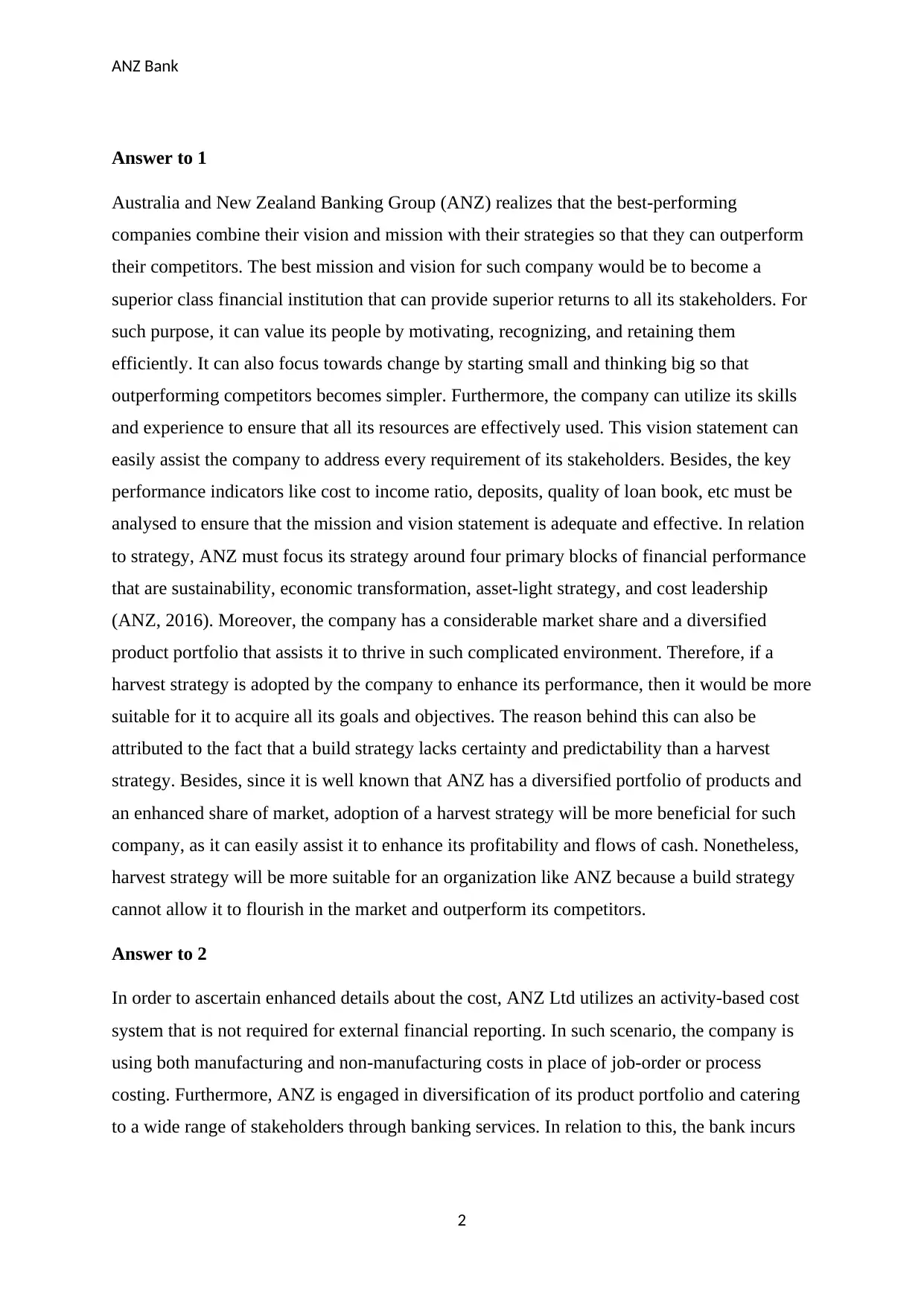
ANZ Bank
Answer to 1
Australia and New Zealand Banking Group (ANZ) realizes that the best-performing
companies combine their vision and mission with their strategies so that they can outperform
their competitors. The best mission and vision for such company would be to become a
superior class financial institution that can provide superior returns to all its stakeholders. For
such purpose, it can value its people by motivating, recognizing, and retaining them
efficiently. It can also focus towards change by starting small and thinking big so that
outperforming competitors becomes simpler. Furthermore, the company can utilize its skills
and experience to ensure that all its resources are effectively used. This vision statement can
easily assist the company to address every requirement of its stakeholders. Besides, the key
performance indicators like cost to income ratio, deposits, quality of loan book, etc must be
analysed to ensure that the mission and vision statement is adequate and effective. In relation
to strategy, ANZ must focus its strategy around four primary blocks of financial performance
that are sustainability, economic transformation, asset-light strategy, and cost leadership
(ANZ, 2016). Moreover, the company has a considerable market share and a diversified
product portfolio that assists it to thrive in such complicated environment. Therefore, if a
harvest strategy is adopted by the company to enhance its performance, then it would be more
suitable for it to acquire all its goals and objectives. The reason behind this can also be
attributed to the fact that a build strategy lacks certainty and predictability than a harvest
strategy. Besides, since it is well known that ANZ has a diversified portfolio of products and
an enhanced share of market, adoption of a harvest strategy will be more beneficial for such
company, as it can easily assist it to enhance its profitability and flows of cash. Nonetheless,
harvest strategy will be more suitable for an organization like ANZ because a build strategy
cannot allow it to flourish in the market and outperform its competitors.
Answer to 2
In order to ascertain enhanced details about the cost, ANZ Ltd utilizes an activity-based cost
system that is not required for external financial reporting. In such scenario, the company is
using both manufacturing and non-manufacturing costs in place of job-order or process
costing. Furthermore, ANZ is engaged in diversification of its product portfolio and catering
to a wide range of stakeholders through banking services. In relation to this, the bank incurs
2
Answer to 1
Australia and New Zealand Banking Group (ANZ) realizes that the best-performing
companies combine their vision and mission with their strategies so that they can outperform
their competitors. The best mission and vision for such company would be to become a
superior class financial institution that can provide superior returns to all its stakeholders. For
such purpose, it can value its people by motivating, recognizing, and retaining them
efficiently. It can also focus towards change by starting small and thinking big so that
outperforming competitors becomes simpler. Furthermore, the company can utilize its skills
and experience to ensure that all its resources are effectively used. This vision statement can
easily assist the company to address every requirement of its stakeholders. Besides, the key
performance indicators like cost to income ratio, deposits, quality of loan book, etc must be
analysed to ensure that the mission and vision statement is adequate and effective. In relation
to strategy, ANZ must focus its strategy around four primary blocks of financial performance
that are sustainability, economic transformation, asset-light strategy, and cost leadership
(ANZ, 2016). Moreover, the company has a considerable market share and a diversified
product portfolio that assists it to thrive in such complicated environment. Therefore, if a
harvest strategy is adopted by the company to enhance its performance, then it would be more
suitable for it to acquire all its goals and objectives. The reason behind this can also be
attributed to the fact that a build strategy lacks certainty and predictability than a harvest
strategy. Besides, since it is well known that ANZ has a diversified portfolio of products and
an enhanced share of market, adoption of a harvest strategy will be more beneficial for such
company, as it can easily assist it to enhance its profitability and flows of cash. Nonetheless,
harvest strategy will be more suitable for an organization like ANZ because a build strategy
cannot allow it to flourish in the market and outperform its competitors.
Answer to 2
In order to ascertain enhanced details about the cost, ANZ Ltd utilizes an activity-based cost
system that is not required for external financial reporting. In such scenario, the company is
using both manufacturing and non-manufacturing costs in place of job-order or process
costing. Furthermore, ANZ is engaged in diversification of its product portfolio and catering
to a wide range of stakeholders through banking services. In relation to this, the bank incurs
2
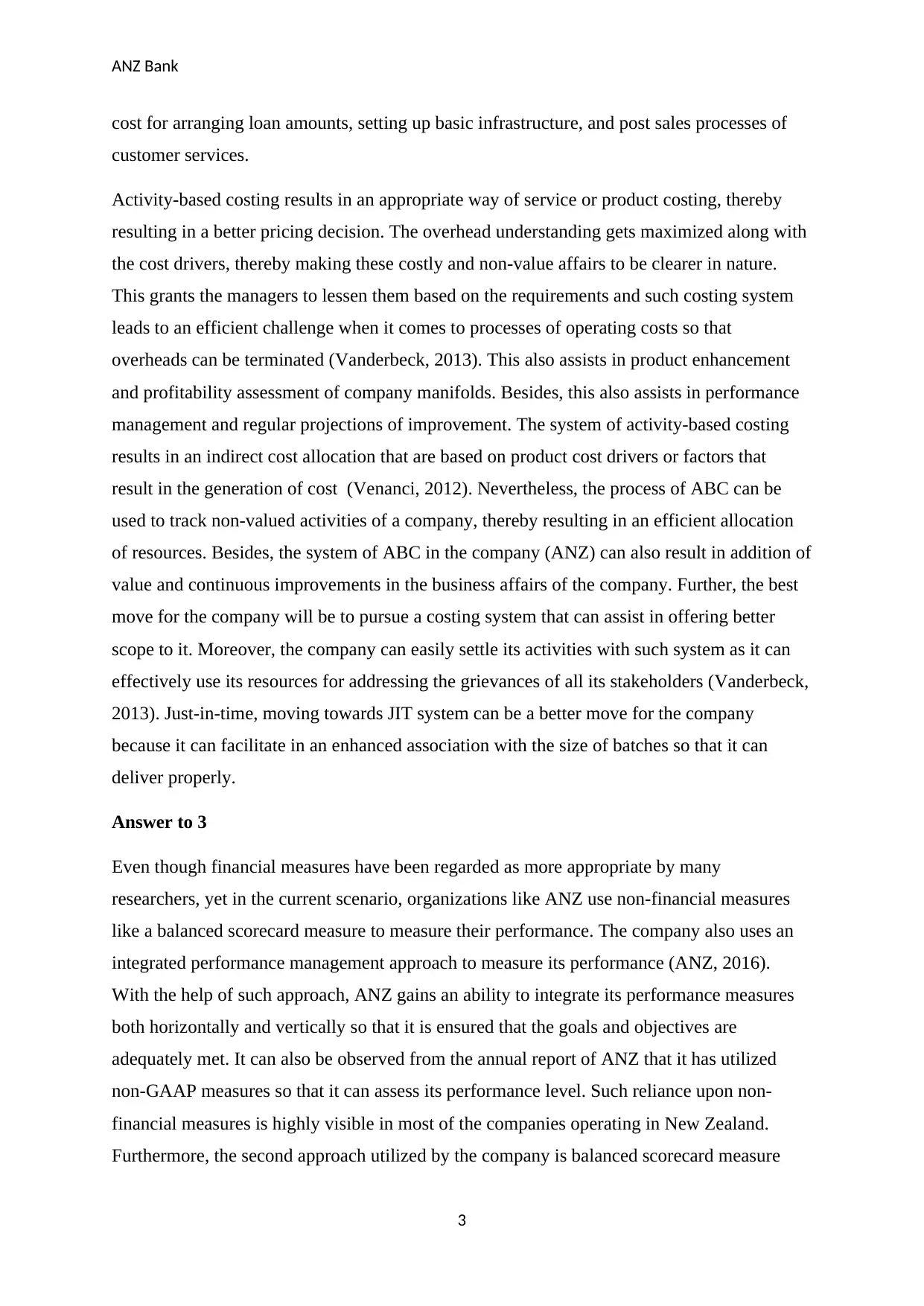
ANZ Bank
cost for arranging loan amounts, setting up basic infrastructure, and post sales processes of
customer services.
Activity-based costing results in an appropriate way of service or product costing, thereby
resulting in a better pricing decision. The overhead understanding gets maximized along with
the cost drivers, thereby making these costly and non-value affairs to be clearer in nature.
This grants the managers to lessen them based on the requirements and such costing system
leads to an efficient challenge when it comes to processes of operating costs so that
overheads can be terminated (Vanderbeck, 2013). This also assists in product enhancement
and profitability assessment of company manifolds. Besides, this also assists in performance
management and regular projections of improvement. The system of activity-based costing
results in an indirect cost allocation that are based on product cost drivers or factors that
result in the generation of cost (Venanci, 2012). Nevertheless, the process of ABC can be
used to track non-valued activities of a company, thereby resulting in an efficient allocation
of resources. Besides, the system of ABC in the company (ANZ) can also result in addition of
value and continuous improvements in the business affairs of the company. Further, the best
move for the company will be to pursue a costing system that can assist in offering better
scope to it. Moreover, the company can easily settle its activities with such system as it can
effectively use its resources for addressing the grievances of all its stakeholders (Vanderbeck,
2013). Just-in-time, moving towards JIT system can be a better move for the company
because it can facilitate in an enhanced association with the size of batches so that it can
deliver properly.
Answer to 3
Even though financial measures have been regarded as more appropriate by many
researchers, yet in the current scenario, organizations like ANZ use non-financial measures
like a balanced scorecard measure to measure their performance. The company also uses an
integrated performance management approach to measure its performance (ANZ, 2016).
With the help of such approach, ANZ gains an ability to integrate its performance measures
both horizontally and vertically so that it is ensured that the goals and objectives are
adequately met. It can also be observed from the annual report of ANZ that it has utilized
non-GAAP measures so that it can assess its performance level. Such reliance upon non-
financial measures is highly visible in most of the companies operating in New Zealand.
Furthermore, the second approach utilized by the company is balanced scorecard measure
3
cost for arranging loan amounts, setting up basic infrastructure, and post sales processes of
customer services.
Activity-based costing results in an appropriate way of service or product costing, thereby
resulting in a better pricing decision. The overhead understanding gets maximized along with
the cost drivers, thereby making these costly and non-value affairs to be clearer in nature.
This grants the managers to lessen them based on the requirements and such costing system
leads to an efficient challenge when it comes to processes of operating costs so that
overheads can be terminated (Vanderbeck, 2013). This also assists in product enhancement
and profitability assessment of company manifolds. Besides, this also assists in performance
management and regular projections of improvement. The system of activity-based costing
results in an indirect cost allocation that are based on product cost drivers or factors that
result in the generation of cost (Venanci, 2012). Nevertheless, the process of ABC can be
used to track non-valued activities of a company, thereby resulting in an efficient allocation
of resources. Besides, the system of ABC in the company (ANZ) can also result in addition of
value and continuous improvements in the business affairs of the company. Further, the best
move for the company will be to pursue a costing system that can assist in offering better
scope to it. Moreover, the company can easily settle its activities with such system as it can
effectively use its resources for addressing the grievances of all its stakeholders (Vanderbeck,
2013). Just-in-time, moving towards JIT system can be a better move for the company
because it can facilitate in an enhanced association with the size of batches so that it can
deliver properly.
Answer to 3
Even though financial measures have been regarded as more appropriate by many
researchers, yet in the current scenario, organizations like ANZ use non-financial measures
like a balanced scorecard measure to measure their performance. The company also uses an
integrated performance management approach to measure its performance (ANZ, 2016).
With the help of such approach, ANZ gains an ability to integrate its performance measures
both horizontally and vertically so that it is ensured that the goals and objectives are
adequately met. It can also be observed from the annual report of ANZ that it has utilized
non-GAAP measures so that it can assess its performance level. Such reliance upon non-
financial measures is highly visible in most of the companies operating in New Zealand.
Furthermore, the second approach utilized by the company is balanced scorecard measure
3
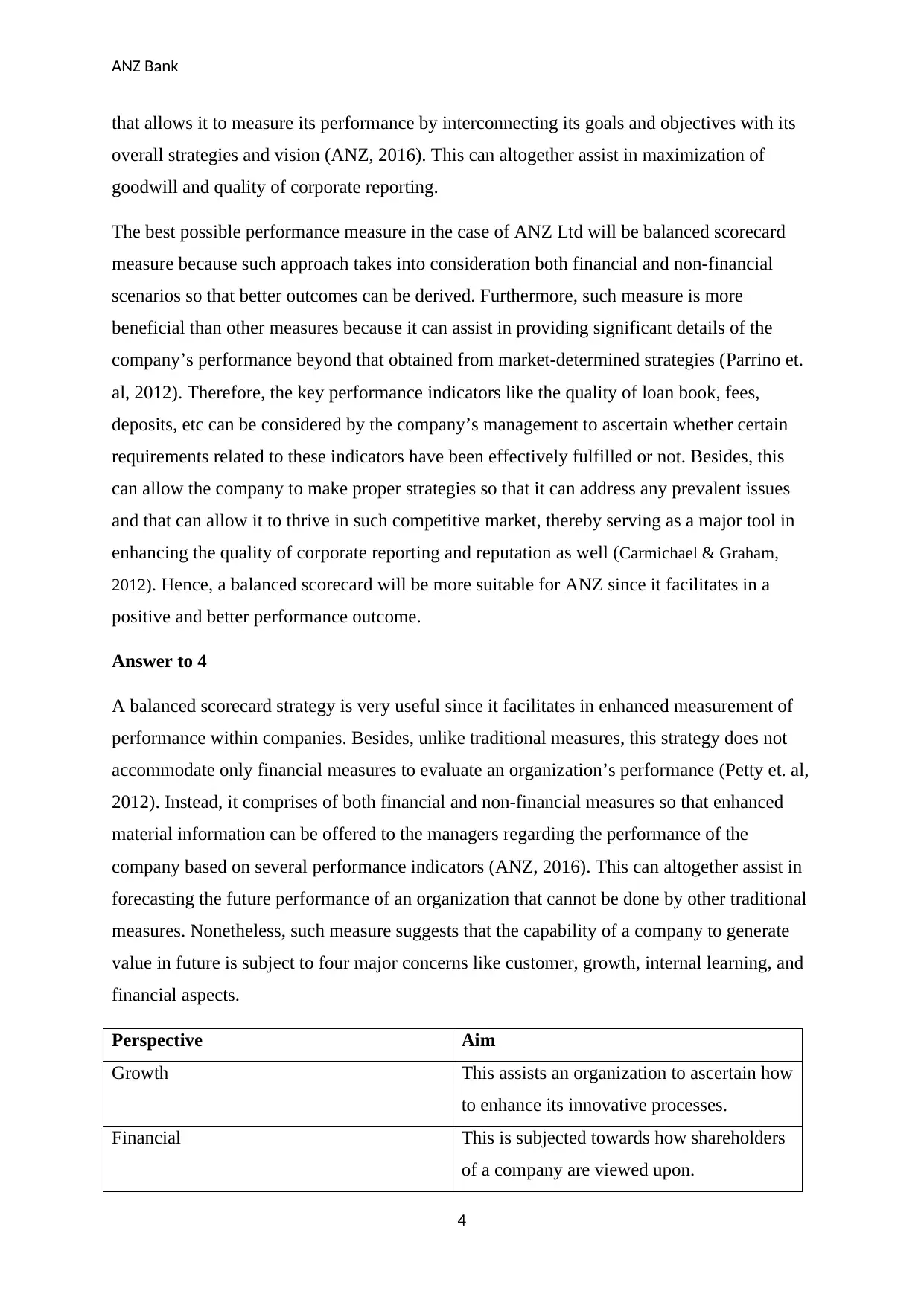
ANZ Bank
that allows it to measure its performance by interconnecting its goals and objectives with its
overall strategies and vision (ANZ, 2016). This can altogether assist in maximization of
goodwill and quality of corporate reporting.
The best possible performance measure in the case of ANZ Ltd will be balanced scorecard
measure because such approach takes into consideration both financial and non-financial
scenarios so that better outcomes can be derived. Furthermore, such measure is more
beneficial than other measures because it can assist in providing significant details of the
company’s performance beyond that obtained from market-determined strategies (Parrino et.
al, 2012). Therefore, the key performance indicators like the quality of loan book, fees,
deposits, etc can be considered by the company’s management to ascertain whether certain
requirements related to these indicators have been effectively fulfilled or not. Besides, this
can allow the company to make proper strategies so that it can address any prevalent issues
and that can allow it to thrive in such competitive market, thereby serving as a major tool in
enhancing the quality of corporate reporting and reputation as well (Carmichael & Graham,
2012). Hence, a balanced scorecard will be more suitable for ANZ since it facilitates in a
positive and better performance outcome.
Answer to 4
A balanced scorecard strategy is very useful since it facilitates in enhanced measurement of
performance within companies. Besides, unlike traditional measures, this strategy does not
accommodate only financial measures to evaluate an organization’s performance (Petty et. al,
2012). Instead, it comprises of both financial and non-financial measures so that enhanced
material information can be offered to the managers regarding the performance of the
company based on several performance indicators (ANZ, 2016). This can altogether assist in
forecasting the future performance of an organization that cannot be done by other traditional
measures. Nonetheless, such measure suggests that the capability of a company to generate
value in future is subject to four major concerns like customer, growth, internal learning, and
financial aspects.
Perspective Aim
Growth This assists an organization to ascertain how
to enhance its innovative processes.
Financial This is subjected towards how shareholders
of a company are viewed upon.
4
that allows it to measure its performance by interconnecting its goals and objectives with its
overall strategies and vision (ANZ, 2016). This can altogether assist in maximization of
goodwill and quality of corporate reporting.
The best possible performance measure in the case of ANZ Ltd will be balanced scorecard
measure because such approach takes into consideration both financial and non-financial
scenarios so that better outcomes can be derived. Furthermore, such measure is more
beneficial than other measures because it can assist in providing significant details of the
company’s performance beyond that obtained from market-determined strategies (Parrino et.
al, 2012). Therefore, the key performance indicators like the quality of loan book, fees,
deposits, etc can be considered by the company’s management to ascertain whether certain
requirements related to these indicators have been effectively fulfilled or not. Besides, this
can allow the company to make proper strategies so that it can address any prevalent issues
and that can allow it to thrive in such competitive market, thereby serving as a major tool in
enhancing the quality of corporate reporting and reputation as well (Carmichael & Graham,
2012). Hence, a balanced scorecard will be more suitable for ANZ since it facilitates in a
positive and better performance outcome.
Answer to 4
A balanced scorecard strategy is very useful since it facilitates in enhanced measurement of
performance within companies. Besides, unlike traditional measures, this strategy does not
accommodate only financial measures to evaluate an organization’s performance (Petty et. al,
2012). Instead, it comprises of both financial and non-financial measures so that enhanced
material information can be offered to the managers regarding the performance of the
company based on several performance indicators (ANZ, 2016). This can altogether assist in
forecasting the future performance of an organization that cannot be done by other traditional
measures. Nonetheless, such measure suggests that the capability of a company to generate
value in future is subject to four major concerns like customer, growth, internal learning, and
financial aspects.
Perspective Aim
Growth This assists an organization to ascertain how
to enhance its innovative processes.
Financial This is subjected towards how shareholders
of a company are viewed upon.
4
Secure Best Marks with AI Grader
Need help grading? Try our AI Grader for instant feedback on your assignments.
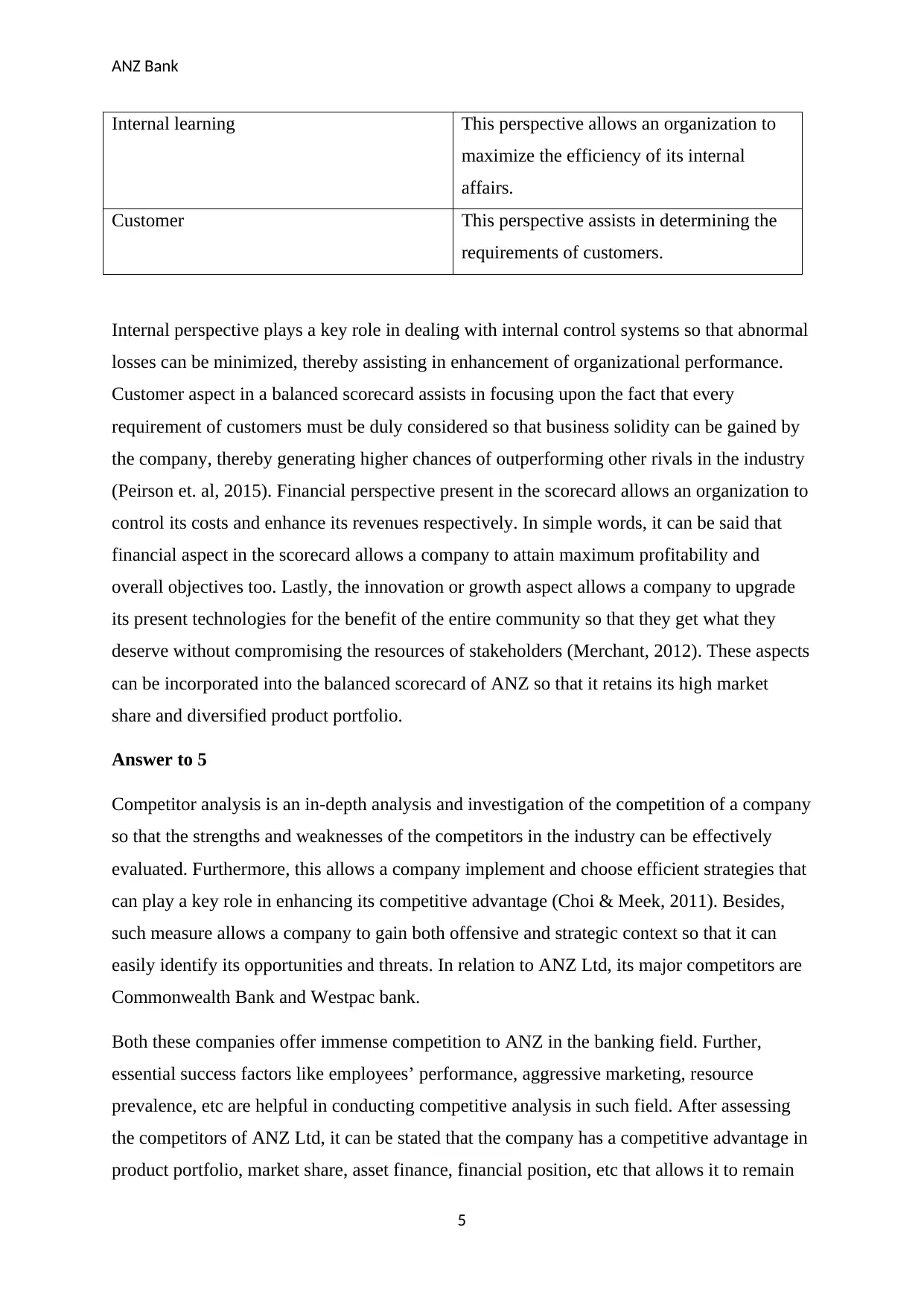
ANZ Bank
Internal learning This perspective allows an organization to
maximize the efficiency of its internal
affairs.
Customer This perspective assists in determining the
requirements of customers.
Internal perspective plays a key role in dealing with internal control systems so that abnormal
losses can be minimized, thereby assisting in enhancement of organizational performance.
Customer aspect in a balanced scorecard assists in focusing upon the fact that every
requirement of customers must be duly considered so that business solidity can be gained by
the company, thereby generating higher chances of outperforming other rivals in the industry
(Peirson et. al, 2015). Financial perspective present in the scorecard allows an organization to
control its costs and enhance its revenues respectively. In simple words, it can be said that
financial aspect in the scorecard allows a company to attain maximum profitability and
overall objectives too. Lastly, the innovation or growth aspect allows a company to upgrade
its present technologies for the benefit of the entire community so that they get what they
deserve without compromising the resources of stakeholders (Merchant, 2012). These aspects
can be incorporated into the balanced scorecard of ANZ so that it retains its high market
share and diversified product portfolio.
Answer to 5
Competitor analysis is an in-depth analysis and investigation of the competition of a company
so that the strengths and weaknesses of the competitors in the industry can be effectively
evaluated. Furthermore, this allows a company implement and choose efficient strategies that
can play a key role in enhancing its competitive advantage (Choi & Meek, 2011). Besides,
such measure allows a company to gain both offensive and strategic context so that it can
easily identify its opportunities and threats. In relation to ANZ Ltd, its major competitors are
Commonwealth Bank and Westpac bank.
Both these companies offer immense competition to ANZ in the banking field. Further,
essential success factors like employees’ performance, aggressive marketing, resource
prevalence, etc are helpful in conducting competitive analysis in such field. After assessing
the competitors of ANZ Ltd, it can be stated that the company has a competitive advantage in
product portfolio, market share, asset finance, financial position, etc that allows it to remain
5
Internal learning This perspective allows an organization to
maximize the efficiency of its internal
affairs.
Customer This perspective assists in determining the
requirements of customers.
Internal perspective plays a key role in dealing with internal control systems so that abnormal
losses can be minimized, thereby assisting in enhancement of organizational performance.
Customer aspect in a balanced scorecard assists in focusing upon the fact that every
requirement of customers must be duly considered so that business solidity can be gained by
the company, thereby generating higher chances of outperforming other rivals in the industry
(Peirson et. al, 2015). Financial perspective present in the scorecard allows an organization to
control its costs and enhance its revenues respectively. In simple words, it can be said that
financial aspect in the scorecard allows a company to attain maximum profitability and
overall objectives too. Lastly, the innovation or growth aspect allows a company to upgrade
its present technologies for the benefit of the entire community so that they get what they
deserve without compromising the resources of stakeholders (Merchant, 2012). These aspects
can be incorporated into the balanced scorecard of ANZ so that it retains its high market
share and diversified product portfolio.
Answer to 5
Competitor analysis is an in-depth analysis and investigation of the competition of a company
so that the strengths and weaknesses of the competitors in the industry can be effectively
evaluated. Furthermore, this allows a company implement and choose efficient strategies that
can play a key role in enhancing its competitive advantage (Choi & Meek, 2011). Besides,
such measure allows a company to gain both offensive and strategic context so that it can
easily identify its opportunities and threats. In relation to ANZ Ltd, its major competitors are
Commonwealth Bank and Westpac bank.
Both these companies offer immense competition to ANZ in the banking field. Further,
essential success factors like employees’ performance, aggressive marketing, resource
prevalence, etc are helpful in conducting competitive analysis in such field. After assessing
the competitors of ANZ Ltd, it can be stated that the company has a competitive advantage in
product portfolio, market share, asset finance, financial position, etc that allows it to remain
5
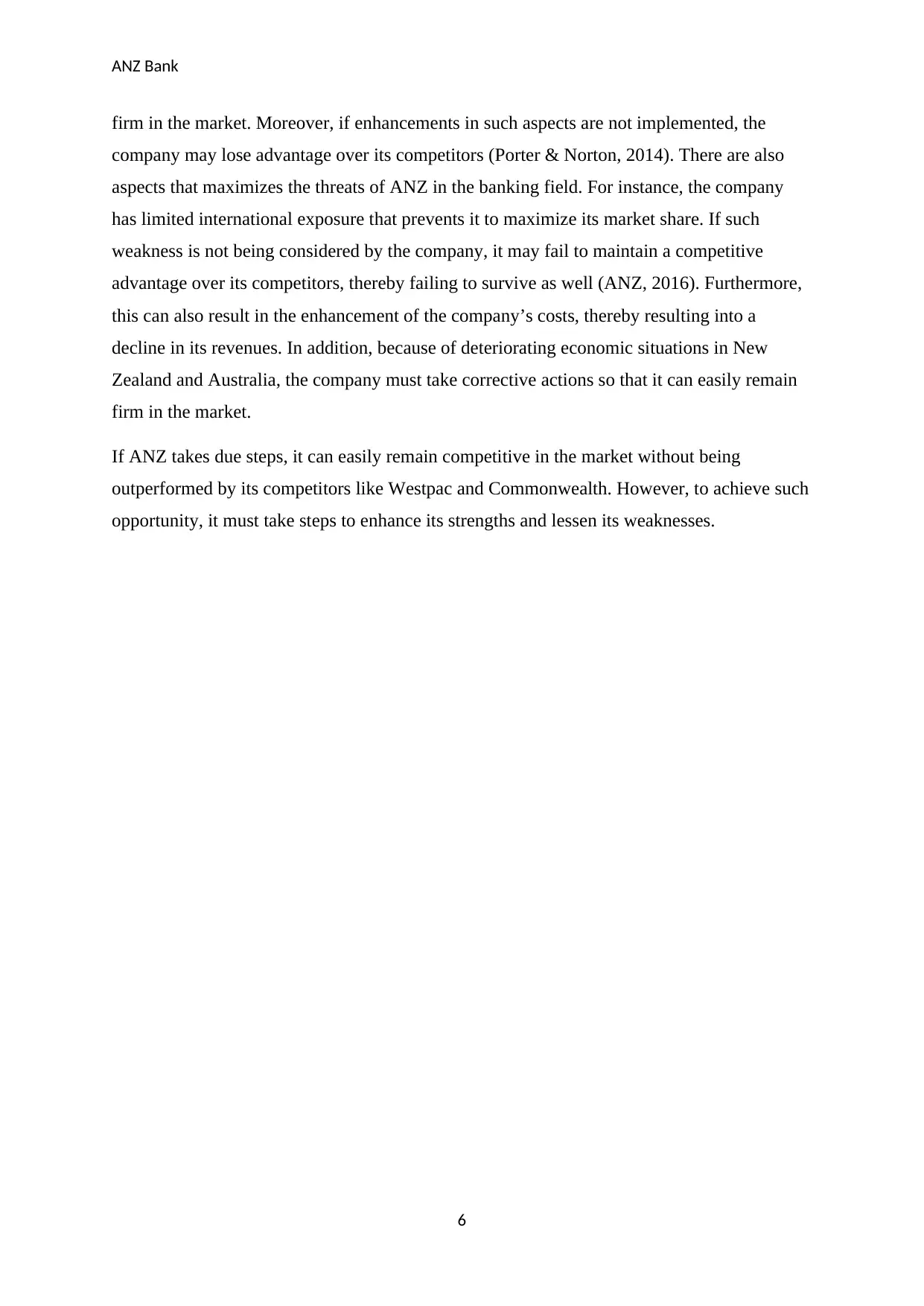
ANZ Bank
firm in the market. Moreover, if enhancements in such aspects are not implemented, the
company may lose advantage over its competitors (Porter & Norton, 2014). There are also
aspects that maximizes the threats of ANZ in the banking field. For instance, the company
has limited international exposure that prevents it to maximize its market share. If such
weakness is not being considered by the company, it may fail to maintain a competitive
advantage over its competitors, thereby failing to survive as well (ANZ, 2016). Furthermore,
this can also result in the enhancement of the company’s costs, thereby resulting into a
decline in its revenues. In addition, because of deteriorating economic situations in New
Zealand and Australia, the company must take corrective actions so that it can easily remain
firm in the market.
If ANZ takes due steps, it can easily remain competitive in the market without being
outperformed by its competitors like Westpac and Commonwealth. However, to achieve such
opportunity, it must take steps to enhance its strengths and lessen its weaknesses.
6
firm in the market. Moreover, if enhancements in such aspects are not implemented, the
company may lose advantage over its competitors (Porter & Norton, 2014). There are also
aspects that maximizes the threats of ANZ in the banking field. For instance, the company
has limited international exposure that prevents it to maximize its market share. If such
weakness is not being considered by the company, it may fail to maintain a competitive
advantage over its competitors, thereby failing to survive as well (ANZ, 2016). Furthermore,
this can also result in the enhancement of the company’s costs, thereby resulting into a
decline in its revenues. In addition, because of deteriorating economic situations in New
Zealand and Australia, the company must take corrective actions so that it can easily remain
firm in the market.
If ANZ takes due steps, it can easily remain competitive in the market without being
outperformed by its competitors like Westpac and Commonwealth. However, to achieve such
opportunity, it must take steps to enhance its strengths and lessen its weaknesses.
6
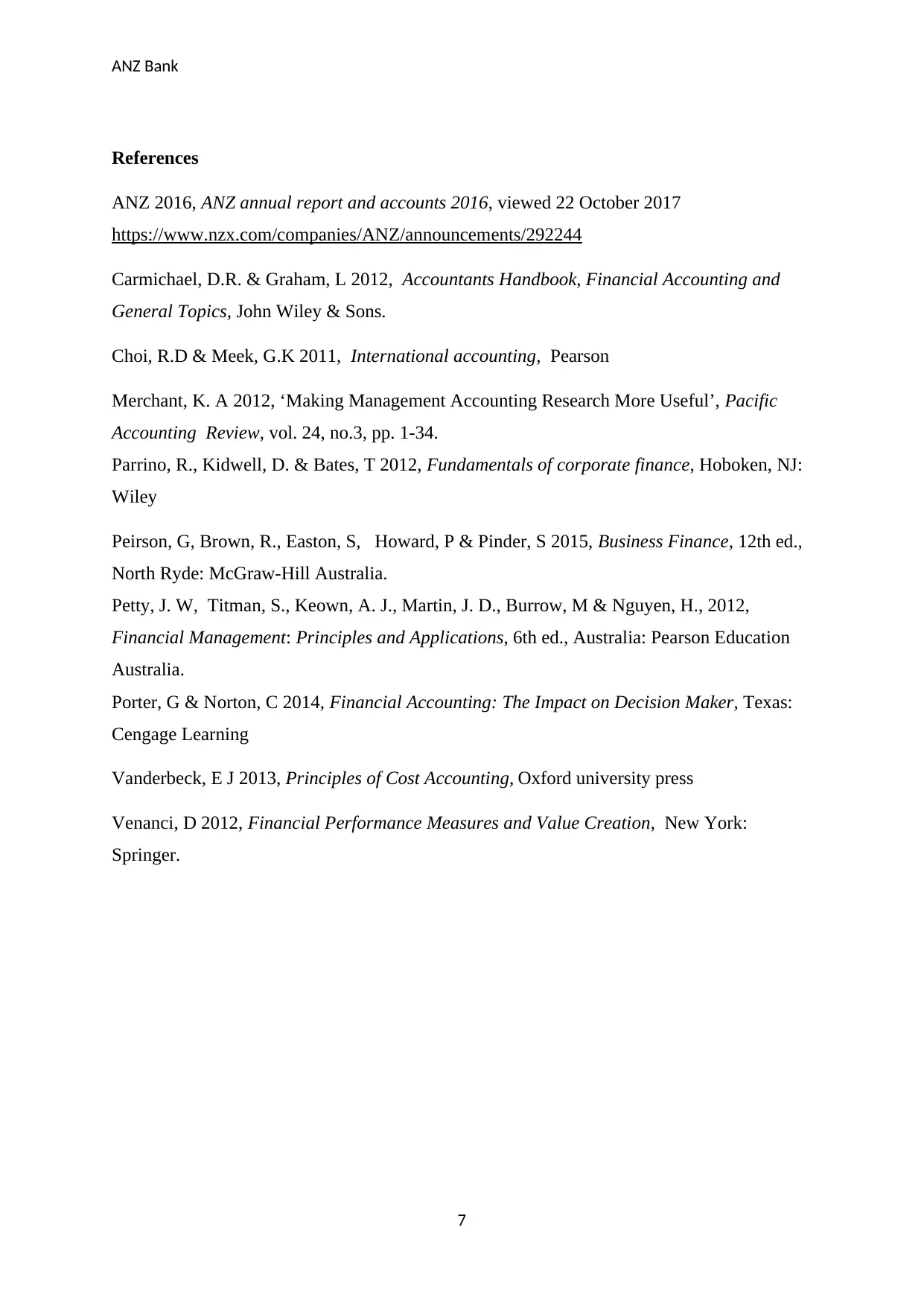
ANZ Bank
References
ANZ 2016, ANZ annual report and accounts 2016, viewed 22 October 2017
https://www.nzx.com/companies/ANZ/announcements/292244
Carmichael, D.R. & Graham, L 2012, Accountants Handbook, Financial Accounting and
General Topics, John Wiley & Sons.
Choi, R.D & Meek, G.K 2011, International accounting, Pearson
Merchant, K. A 2012, ‘Making Management Accounting Research More Useful’, Pacific
Accounting Review, vol. 24, no.3, pp. 1-34.
Parrino, R., Kidwell, D. & Bates, T 2012, Fundamentals of corporate finance, Hoboken, NJ:
Wiley
Peirson, G, Brown, R., Easton, S, Howard, P & Pinder, S 2015, Business Finance, 12th ed.,
North Ryde: McGraw-Hill Australia.
Petty, J. W, Titman, S., Keown, A. J., Martin, J. D., Burrow, M & Nguyen, H., 2012,
Financial Management: Principles and Applications, 6th ed., Australia: Pearson Education
Australia.
Porter, G & Norton, C 2014, Financial Accounting: The Impact on Decision Maker, Texas:
Cengage Learning
Vanderbeck, E J 2013, Principles of Cost Accounting, Oxford university press
Venanci, D 2012, Financial Performance Measures and Value Creation, New York:
Springer.
7
References
ANZ 2016, ANZ annual report and accounts 2016, viewed 22 October 2017
https://www.nzx.com/companies/ANZ/announcements/292244
Carmichael, D.R. & Graham, L 2012, Accountants Handbook, Financial Accounting and
General Topics, John Wiley & Sons.
Choi, R.D & Meek, G.K 2011, International accounting, Pearson
Merchant, K. A 2012, ‘Making Management Accounting Research More Useful’, Pacific
Accounting Review, vol. 24, no.3, pp. 1-34.
Parrino, R., Kidwell, D. & Bates, T 2012, Fundamentals of corporate finance, Hoboken, NJ:
Wiley
Peirson, G, Brown, R., Easton, S, Howard, P & Pinder, S 2015, Business Finance, 12th ed.,
North Ryde: McGraw-Hill Australia.
Petty, J. W, Titman, S., Keown, A. J., Martin, J. D., Burrow, M & Nguyen, H., 2012,
Financial Management: Principles and Applications, 6th ed., Australia: Pearson Education
Australia.
Porter, G & Norton, C 2014, Financial Accounting: The Impact on Decision Maker, Texas:
Cengage Learning
Vanderbeck, E J 2013, Principles of Cost Accounting, Oxford university press
Venanci, D 2012, Financial Performance Measures and Value Creation, New York:
Springer.
7
1 out of 7
Related Documents
Your All-in-One AI-Powered Toolkit for Academic Success.
+13062052269
info@desklib.com
Available 24*7 on WhatsApp / Email
![[object Object]](/_next/static/media/star-bottom.7253800d.svg)
Unlock your academic potential
© 2024 | Zucol Services PVT LTD | All rights reserved.





